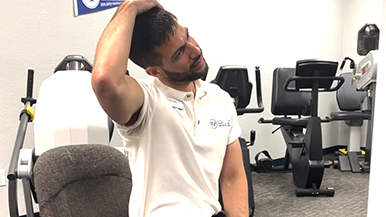- What does pelvic health have to do with pregnancy?
- How can pelvic exercises help pregnancy?
- What pelvic exercises should you do during pregnancy?
During pregnancy, a woman’s body undergoes dramatic changes to prepare for labor and childbirth. The process is strenuous and demands a lot from your body. Conditioning your body for childbirth can ease this process and improve your overall physical well-being before and after pregnancy. Ability Rehabilitation works with pregnant women to prepare them for the joy—and job—of giving birth.
Tezia Gonzales, PT, DPT, board-certified orthopedic physical therapist, is the Director of Ability Rehabilitation of Winter Garden. She says, “Pregnancy is a very exciting time. You have constant thoughts about the future and how much your life is going to change for the better. You probably have so many ideas about how to care for your baby, both before and after birth. But what about you?”
Tezia and the team at Ability Rehabilitation offer a series of recommendations that can prepare your body for pregnancy and leave you feeling confident about the childbirth process. We’ll go over what you need to know about pelvic health and the different exercises that can make you stronger and healthier for the birth of your baby.
What Does Pelvic Health Have to Do with Pregnancy?
A successful pregnancy and delivery depend on the health of your pelvic floor, which is the area above the tops of your thighs and below your belly button. Under the skin is a complex network of muscles, ligaments, and a circulatory system that ensures the connective tissues can not only carry a pregnancy for nine months but are capable of delivering a healthy baby.
Strengthening your pelvic area can greatly improve your chances of a successful pregnancy and delivery. Going through pregnancy strains these muscle groups and conditioning your body beforehand can help you cope with the added stress. Exercising your pelvic floor throughout your pregnancy ensures these muscles function well before and after delivery. In general, women don’t think about pelvic health until after their pregnancy when they experience bowel and bladder issues.
For many women, pregnancy can weaken the pelvic floor muscles, making it harder to control their bladders. Fortunately, Tezia says, “Exercise can be helpful to the mother for many reasons.” That includes strengthening the pelvic floor.
How Can Pelvic Exercises Help Pregnancy?
Tezia says, “Your body is a temple to that baby for nine months. You have to take care of it. This of course includes eating well, taking the proper vitamins, but also exercising and stretching.”
For many of her patients, these exercises can help with:
- Depression
- Improve energy levels
- Improve circulation
- Improve sleeping patterns
- Increase relaxation and enhance mood
- Increase strength and endurance
- Pregnancy complications like gestational diabetes and hypertension
- Prevent muscle and leg cramps
- Prevent muscle tightness and back or muscle pain
- Reduce bloating
- Reduce swelling and digestion issues
Tezia says, “Recent research even shows that babies of Moms who exercise have a stronger and healthier heart.”
She reminds us that exercising the pelvic floor during pregnancy is different from a traditional gym workout, “you want to ensure proper technique to avoid any injury. Don’t overdo it. Avoid too much heat and humidity. Slow and controlled movements due to your constantly changing center of gravity, which may alter your sense of balance.” It’s a good idea to consult with a physical therapist before beginning these exercises. Tezia says, “Certain positions should also be avoided or held for a short term during the second or third trimester.”
Exercise caution during these times by avoiding:
- Lying on your back for more than one or two minutes (this can reduce blood flow)
- Crunch positions (i.e. sit-ups)
- Deep twisting movements (focus on stabilization instead)
- Intense abdominal workouts (these exercises can weaken muscles as they stretch to accommodate the pregnancy)
- Prone positions or lying on the stomach
Now that you know what not to do, what regular pelvic exercises are beneficial during pregnancy?
What Pelvic Exercises Should You Do During Pregnancy?
Deep Yoga Squat
Get into a wide stance with your feet as far apart as you feel comfortable. Squat slowly, keeping your feet flat while pushing your elbows into your inner thighs. Your knees should spread wide and your feet point away from the body. Hold the stretch for a minute or two. Tezia says, “If it feels difficult, you can always start with about 30-seconds.”
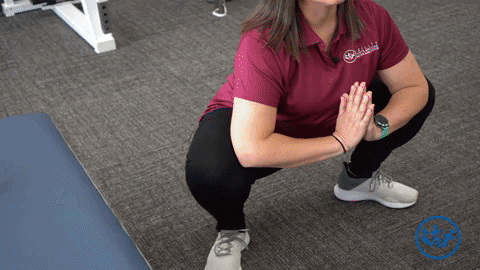
Hamstring Stretch
It’s easier to perform this exercise from a seated position. Stretch one knee straight out in front of you with your heel on the floor. If you feel tingling in your sciatica nerve, you can lift your heel a little off the floor. Keep your back flat during the exercise and then gently lean forward toward the extended foot. You’re looking for a light to medium gentle stretch down the leg. Now, reverse and do the opposite leg.
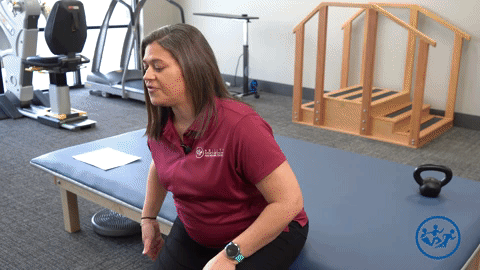
Diaphragmatic Breathing
Tezia says diaphragmatic breathing is “good for labor and delivery, relaxation of muscles and just helps to regulate your breathing techniques.” For diaphragmatic breathing, stay seated with good posture. Put one hand on your breastbone and the other hand on your abdomen. This breathing technique stems from your abdomen, right around your belly button. Your chest should not rise and fall–only your abdomen should move. You can also perform this exercise while standing or lying flat, depending on where you are in your pregnancy.
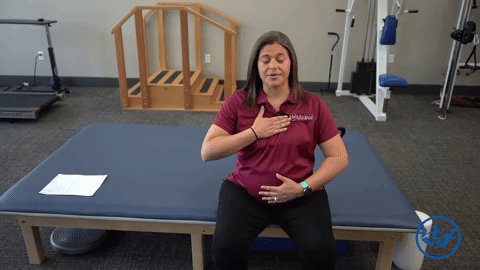
Frog/Groin Stretch
You can perform this exercise in several different positions that are designed to stretch your inner thighs. You can take a seated position with the soles of your feet touching and bring them as close to your body as possible. The same can also be done while lying down. Once your feet are in position, let your knees fall to either side. If this is uncomfortable, you can add pillows under each knee.
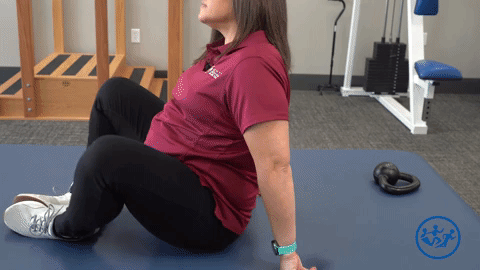
Added Lumbar Flexion
Sit on the floor with your legs stretched out in front of you in a V-shape. The stretch shouldn’t be painful, so only go as far as you feel comfortable. Once you’re in the position, slowly lean forward, keeping your back as straight as possible. Walk your hands toward your feet and avoid putting too much pressure on your abdomen. You should feel a gentle stretch along your inner thighs.
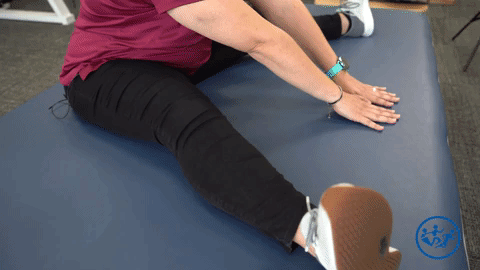
Piriformis Stretch
The piriformis stretch is helpful if you’re experiencing sciatic issues. The best way to do this exercise is lying down. Tezia says, “Early on in the pregnancy this is fine but as you get later on, it might become more difficult.”
From a lying position, raise your knees so your heels are close to your bottom. Your feet should touch the floor, mat, or surface you’re lying on. Cross one leg over the other. Now gently lift the leg touching the floor, bringing your crossed leg toward your belly. You should feel this stretch in the crossed top leg. You should also feel the stretch in your glutes and lower back. If this is too difficult, you can modify the stretch by crossing one leg, pulling the knee gently toward your opposite shoulder. Don’t forget to exercise the other leg by switching sides.
You can also perform the piriformis stretch from a seated position. If you’re sitting, bring your leg on top as if crossing your leg. With a straight back, push down on the crossed knee or pull into it gently to feel a stretch.

Bridge Stretch
The bridge stretch can help strengthen your core. Lay flat on your back with your knees raised comfortably. Your hands should be on either side of the body with the palms down to help stabilize you. Slowly raise your hips, keeping your feet flat on the floor and your shoulders grounded. Keep your glutes and core tight. Raise and hold for a moment and then slowly lower your back to the ground.

Cat-Cow Stretch
If you’ve ever seen a cat stretch, then you know this exercise was named appropriately. The cat posture is not only great for pelvic health but can also stretch out the muscles in your lower back. These movements promote mobility in your hips and spine. Start with your hands and knees on the mat in line with each other comfortably. Slowly lower the belly toward the mat, making your back concave. Breathe deeply, then reverse by arching your back and tucking your tummy inward.
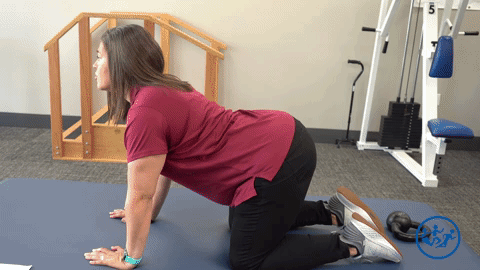
Strength Exercise: Standard Squat
Stand with your feet pointing straight ahead, a hip-width apart. Put your arms out in front with your palms facing down to help with balance. Slowly squat as far as you feel comfortable, keeping your back straight. You can use a chair for balance if you need it. If you want an extra challenge, you can even add weight. You can either squat with the weight held to your chest or, as you squat, raise your arms with the weight outstretched.

Strength Exercise: Lunges
Forward lunges and side lunges both work for this exercise. Tezia says, “Both have benefits for your hips and thighs.” From a standing position, take a step forward with one leg and lower the opposite knee to the ground. Step back to your starting position and repeat with the other leg. Instead of leaning forward, come down straight with a tall back.
For a side lunge, step one foot out to the side, keeping it in line with your other foot. Slowly bend the extended knee, squatting at the side of the body. Keep your hands out for balance and don’t forget to take deep breaths to keep the oxygen flowing. Switch sides.
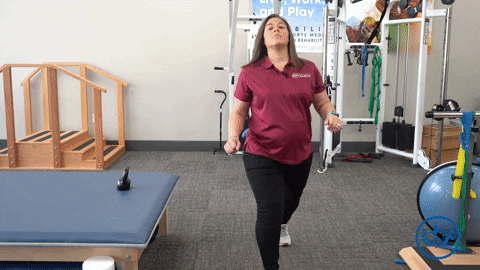
Strength Exercise: Bird-Dog
The most advanced way to perform the bird-dog is on your hands and knees. Slowly lift one leg and point it backward. Now point the opposite hand forward. You should feel the full stretch when your left hand points forward and your right leg points backward. Hold for just a moment. Now switch to the other side.
Remember to keep your pelvis and spine neutral and try not to move them, so your back is nice and flat. However, if you find this exercise challenging, modify it by either pointing your legs or arms.
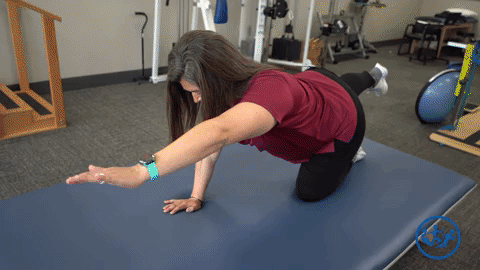
How We Can Help
The team at Ability Rehabilitation is here to help you before, during, and after your pregnancy. We work with our patients to develop custom therapies to strengthen areas of the body that come under stress during pregnancy. Our approach aids your smooth recovery after childbirth and gives you the tools to manage your pelvic health. Call us to find out more about our pelvic health and pregnancy support services.

